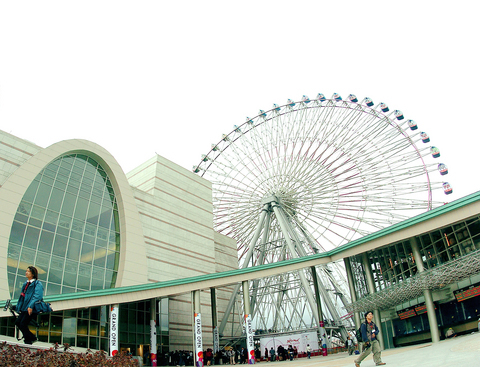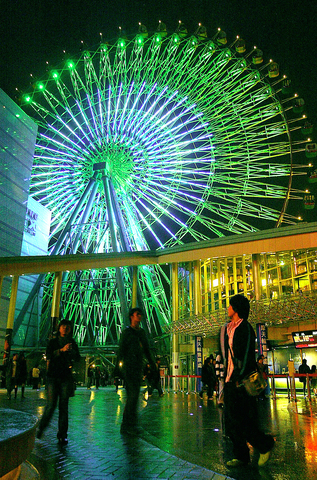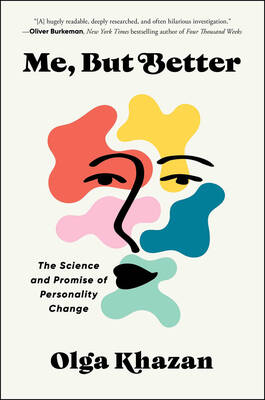Neihu's Miramar Shopping Complex boasts the world's second largest Ferris wheel. At 110m at its highest point and 70m in diameter, the wheel takes about 17 minutes to do a single circuit. With a capacity of 288 passengers -- six people to each of its 48 cars -- it has already proven to be a crowd puller despite being open for just over two months. If you fancy a ride, avoid the weekends unless you have the patience of a saint. You'll have to wait at least an hour in line then and on public holidays. Still, it's an experience not to be missed, and in fact the amusement park rivaled Taipei 101 as the best place to see in the new year.
From the Ferris wheel during the day, it's possible to see the National Palace Museum, all the way out in Waishuangxi and the Taipei 101 building to the south. Probably the best time of day to enjoy the view, however, is dusk, when the sky turns into a deep blue backdrop to the scenery spread out before you.

PHOTO: TAIPEI TIMES
That's not to say, of course, that the night view is without its charms. In fact, you'll be kicking yourself if you forget to take your camera along to capture the city lights from on high.

The wheel itself is lit up with the help of 624 sets of neon lights. There is also a spectacular light show, orchestrated by a Japanese designer, in three parts: the "Melody from Heaven," the "Colors on the Ground" and the "Dances of the Winds."
If you want a ride in the world's biggest Ferris wheel, you'll have have to fork out money for a trip to London, home of the 135m-tall London Eye on the South Bank of the Thames. The Eye, one of the public projects built to commemorate the turn of the millennium four years ago, is still one of the city's biggest tourist draws.
The London Eye takes around 30 minutes to make one circuit, and has 60 passenger cars, each the size of a small bus, holding 20 people. The rides need to be booked in advance, and each car comes with a guide to make sure you don't miss anything. From the top you can see the whole of London, with a view of up to 40km away. In the distance you will even be able to see Windsor Castle.
Sunset is a great time to go, if you want to see London's architecture at its best, lit up against the darkening sky.
A trip to Japan will also get you to a Ferris wheel of note. Tokyo's Odaiba district, known as Palette Town, has what is perhaps the most romantic Ferris wheel to be found anywhere on the globe. It has provided the backdrop to many movie scenes, including scenes in Bayside Shakedown with Yuji Oda. It's also become one of the top choices for Romeos who plan to pop the big question.
Odaiba is Tokyo's newest commercial area, sitting on the side of Tokyo Bay with Rainbow Bridge and the Ferris wheel as landmarks. At 115m tall, the wheel takes 15 minutes to go around once. The scene from the top at nightfall, looking over Tokyo Bay and Shinjuku, with the Rainbow Bridge lit up in seven colors, is simply unforgettable.
Back in Taiwan, there are still a number of choices open to you if you want that Ferris wheel experience nearer to home. In Taichung there is the 28m-high wheel in Yamay Resort's Discovery World which, despite its modest dimensions, offers a comprehensive view of the entire park, as well as the Houli district beyond. It takes a quarter of an hour to make the journey round once, so you can have a while to relax.
On the east coast there is the Hualien Ocean Park, with a Ferris wheel standing 33m high, 68m above sea level. On one side you can get a glimpse of the lush green hills that are the foothills of the central mountain, and on the other you can see the deep blue of the Pacific Ocean.
Janfusun Fancy World in Yunlin used to lay claim to owning the largest Ferris wheel in Taiwan before the one in the Miramar Complex came along. It's still nothing to sniff at: at 30 storeys high, its highest point is 88m. Fifty passenger cars each fit eight people, making its total capacity 400 people, and it takes 15 minutes to go around once.
-- Translated by Paul Cooper

April 14 to April 20 In March 1947, Sising Katadrepan urged the government to drop the “high mountain people” (高山族) designation for Indigenous Taiwanese and refer to them as “Taiwan people” (台灣族). He considered the term derogatory, arguing that it made them sound like animals. The Taiwan Provincial Government agreed to stop using the term, stating that Indigenous Taiwanese suffered all sorts of discrimination and oppression under the Japanese and were forced to live in the mountains as outsiders to society. Now, under the new regime, they would be seen as equals, thus they should be henceforth

Last week, the the National Immigration Agency (NIA) told the legislature that more than 10,000 naturalized Taiwanese citizens from the People’s Republic of China (PRC) risked having their citizenship revoked if they failed to provide proof that they had renounced their Chinese household registration within the next three months. Renunciation is required under the Act Governing Relations Between the People of the Taiwan Area and the Mainland Area (臺灣地區與大陸地區人民關係條例), as amended in 2004, though it was only a legal requirement after 2000. Prior to that, it had been only an administrative requirement since the Nationality Act (國籍法) was established in

Three big changes have transformed the landscape of Taiwan’s local patronage factions: Increasing Democratic Progressive Party (DPP) involvement, rising new factions and the Chinese Nationalist Party’s (KMT) significantly weakened control. GREEN FACTIONS It is said that “south of the Zhuoshui River (濁水溪), there is no blue-green divide,” meaning that from Yunlin County south there is no difference between KMT and DPP politicians. This is not always true, but there is more than a grain of truth to it. Traditionally, DPP factions are viewed as national entities, with their primary function to secure plum positions in the party and government. This is not unusual

The other day, a friend decided to playfully name our individual roles within the group: planner, emotional support, and so on. I was the fault-finder — or, as she put it, “the grumpy teenager” — who points out problems, but doesn’t suggest alternatives. She was only kidding around, but she struck at an insecurity I have: that I’m unacceptably, intolerably negative. My first instinct is to stress-test ideas for potential flaws. This critical tendency serves me well professionally, and feels true to who I am. If I don’t enjoy a film, for example, I don’t swallow my opinion. But I sometimes worry